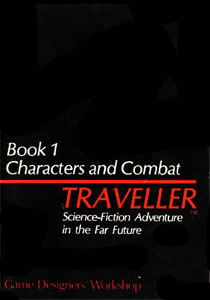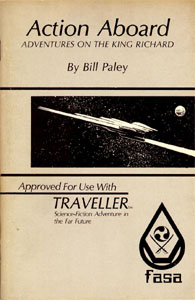 As a brief tangent to our discussion of game structures, how could we go about plugging the “hole” in Traveller’s scenario structure?
As a brief tangent to our discussion of game structures, how could we go about plugging the “hole” in Traveller’s scenario structure?
Since Traveller’s starmaps are hex-based, we could start by rifling through the pockets of the hexcrawl and snagging the concept of “when the PCs enter the hex, trigger the hex’s keyed content”. But what we’ll quickly realize is that there’s a reason Traveller doesn’t do this already: Planets are really, really big.
If we think of a dungeon room or a wilderness hex as a “container” which holds keyed content, it’s pretty easy to recognize that a planet-sized container completely dwarfs the scale of any single encounter or location. Take an encounter and stick it in a dungeon room; it fills the room. Take the same encounter and put it in a wilderness hex; it gets a little bit lonely but there’s still enough to quench our thirst. Stick it on a planet, on the other hand, and the glass still looks completely empty.
And this isn’t just a matter of aesthetics. It impacts the GM’s ability to logically transition the scene: If the PCs are traveling through a wilderness, it’s relatively easy to find a transition from the macro-level of wilderness travel to the micro-level of the keyed encounter. You just say something like, “As you pass through the forest, you see a bunch of orcs.” But this method doesn’t work quite as well if the PCs are approaching a planet.
Perhaps more importantly, this also affects the ability for players to make meaningful decisions within the context of the scenario structure. If the GM of a hexcrawl says, “You see a castle perched upon a rocky crag of blackened stone.” The players can say, “Okay, that looks scary. I think we’ll just skirt it as far to the west as possible.” And they can do that. But if they were to say, in this hypothetical game structure for spacecrawling, “Okay, I don’t want to deal with this settlement of murderous cannibals. Let’s lift-off and land somewhere else on the planet.” Suddenly they’ve exited the purview of the scenario structure.
One logical leap from this conclusion is that we simply need to key more content to the planet. Maybe, for example, we could just map the entire planet and key it as a hexcrawl: Thus, just like a hexcrawl contains dungeoncrawls, our spacecrawl would contain hexcrawls.
But hexmapping and keying an entire planet in any sort of meaningful or interesting detail? That’s an absurd amount of work. It’s obviously completely impractical.
HAILING FREQUENCIES OPEN
So maybe, instead of that, we let our logic take us the other way. Maybe we accept our limitations and implement a structure where each planet is keyed with a “hail”: When an intrepid band of interstellar scouts enters orbit, they’ll receive the hail.
This basically handles the problem of scale by embracing the old pulp SF trope of “every planet is a village”. The result is less Traveller: Firefly and more Traveller: Star Trek. But as long as the players are onboard with the fact that they have to either engage with Oxymyx and Krako or bypass the planet (i.e., they can’t just decide to head over to the other side of the planet and talk to a different set of gangsters), you’ll probably be in pretty good shape.
Unfortunately, the structure starts to breakdown once you’re dealing with civilized planets (instead of exploration). But, of course, this is also true for traditional hexcrawls (which provide no guidance for PCs once they pass through the gates of Greyhawk).
ABOARD THE KING ARTHUR
Unsurprisingly, I’m not the first person to start thinking this way about Traveller. Back in 1981, FASA produced Action Aboard: Adventures on the King Richard. In addition to detailing the ISCV King Richard and providing two sample adventures, this module included a dozen or so “Outline Adventures”, all of which constitute primitive scenario structures into which any number of specific scenarios could be poured. For example, the Hijack:
The forcible capture of the vessel and its contents may come from either inside or outside the ship.
A) Internal
A hijack from inside assumes that the hijackers and their equipment are all aboard at the beginning of the scenario.
1) Players as crew – the players may or may not be issued weapons from the ship’s locker, depending upon the level of surprise.
2) Players as passengers – The players will not be given weapons and, unless they have social standing A-F, they will be abandoned at any habitable planet (roll 1-4 on one die) or shot, and/or dumped into a vacuum (roll 5 or 6 on one die). If they have high social ranking, they will be ransomed.
And so forth.
Primitive? Yes. Still incomplete? Sure. But you can see how this begins to provide a basic structure into which a few stats can be poured to give you something that can be used in play. In combination with the other “Outline Adventures”, Action Aboard begins to give you enough structure to run an entire campaign based around the voyages of the ISCV King Arthur.












